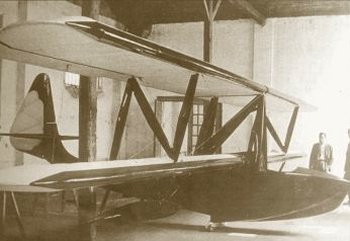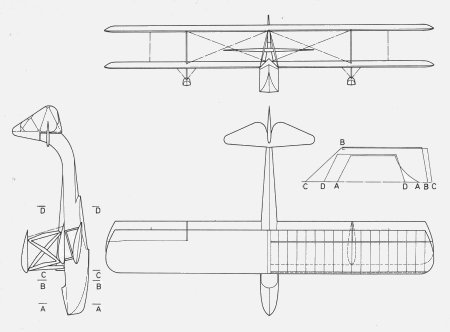| Type designation: | Kócsag |
|---|---|
| Name: | Kócsag |
| Designer: | Zoltán JANKA |
| Class: | Water-borne glider |
| General arrangement: | Biplane, boathull fuselage, traditional tail unit |
| Crew: | 1 |
| First flight: | - |
| Manufacturer: | MOVERO, Gyöngyös |
| Number of built: | 1 |
.jpg)

.jpg)

| Dimensions: | |
|---|---|
| Wing: | |
| Span, m: | 11,5 |
| Area, m2: | 30 |
| Aspect ratio: | 8,8 |
| Chord (root), m: | 1,4 |
| Chord (tip), m: | 1,4 |
| Airfoil (root), m: | ? |
| Airfoil (mid-span), m: | ? |
| Airfoil (tip), m: | ? |
| Dihedral, degree: | 0 |
| Sweep, degree: | 0 |
| Washout: | ? |
| Aileron: | |
| Span, m: | ? |
| Mean chord, m: | ? |
| Total area, m2: | cca. 3,6 |
| Balancing: | ? |
| Flap: | |
| Type: | None |
| Airbrakes: | |
| Type: | None |
| Horizontal stabilizer: | |
| Span, m: | 2,6 |
| Area, m2: | ? |
| Elevator: | |
| Span, m: | 2,6 |
| Area, m2: | ? |
| Airfoil: | ? |
| Balancing: | ? |
| Trim: | ? |
| Vertical stabilizer and rudder: | |
| Total area, m2: | ? |
| Rudder area, m2: | ? |
| Balancing: | ? |
| Fuselage: | |
| Length, m: | 6,8 |
| Width, m: | ? |
| Height: | ? |
| Cross section, m2: | ? |
| Landing gear: | |
| Type: | Boat hull with two support floats under the wing |
| Wheel diameter, m: | - |
| Masses: | |
| Wing, kg: | ? |
| Fuselage, kg: | ? |
| Tail unit, kg: | ? |
| Empty glider, kg: | caa. 220 |
| Gross, kg: | cca. 300 |
| Ballast, kg: | None |
| Wing loading, kg/m2: | cca. 10 |
| Speeds: | |
| VNE, km/h: | ? |
| Max. speed with open airbrakes, km/h: | - |
| Max. aerotow speed, km/h: | ? |
| Max. winch speed, km/h: | - |
| Max. speed in rough air, km/h: | ? |
| Stall speed, km/h: | 40 |
| Performance: | |
| Min. sink, m/s (at gliding speed, km/h): | ?/? |
| Best L/D (at gliding speed, km/h): | ?/? |
| Start methods: | Boat towing |
Origin of data and 3-view drawing:
Jereb Gábor: Magyar vitorlázó repülőgépek, Műszaki Könyvkiadó, 1988, Budapest
(Gábor JEREB: Hungarian Gliders, Technical Publishing House, 1988, Budapest)
Gábor FEKECS E-mail: fekecs.gabor@t-online.hu